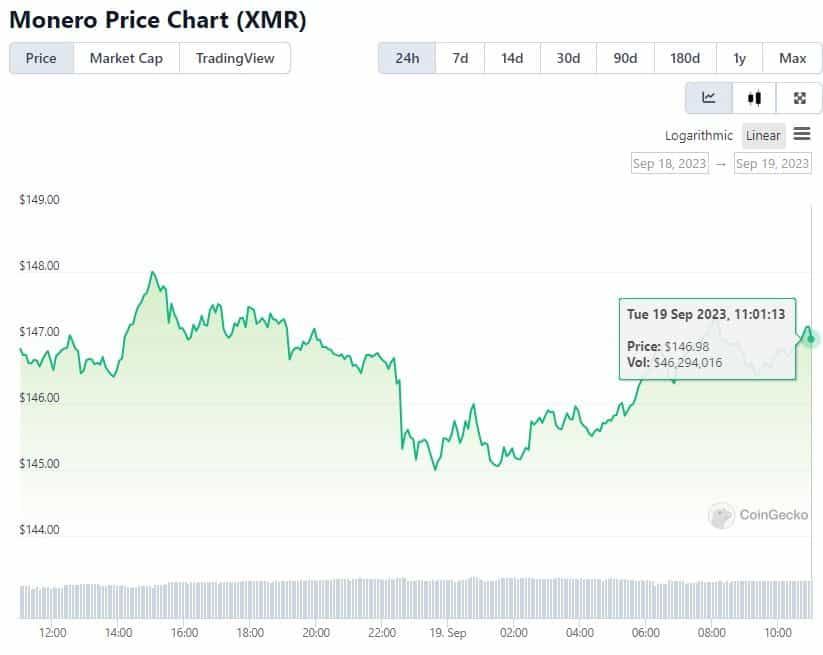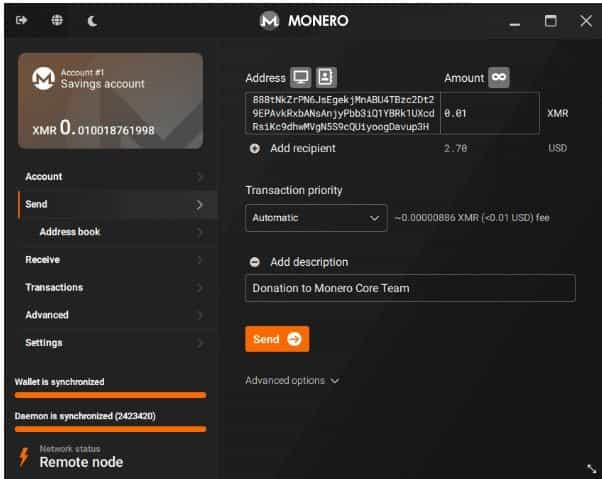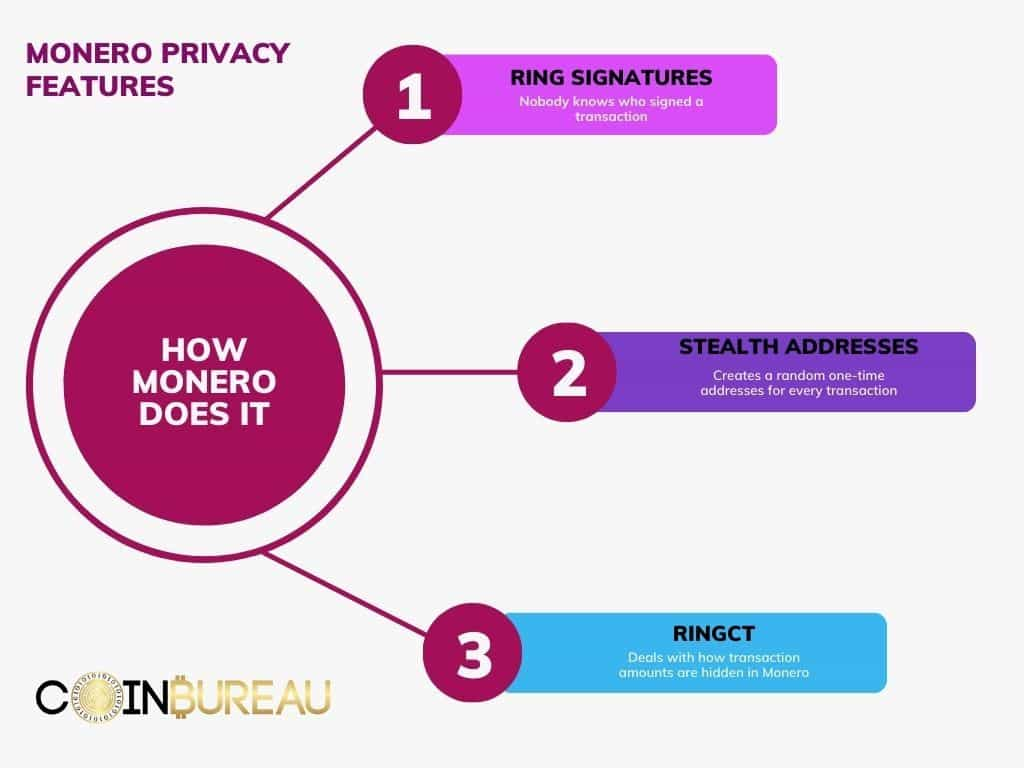In September 2022, Australia's third-largest telecommunications company, Optus, suffered a data breach that affected up to 9.7 million current and former customers, representing over a third of the country's population. The hackers responsible for the attack demanded a ransom of A$1.5 million not in Bitcoin or Ethereum, but in a lesser-known coin known as Monero.
Transparency is a major benefit of blockchain technology, a public ledger recording all transactions. This helps prevent fraud and corruption because anyone with a little bit of knowledge about the underlying technology can identify suspicious transactions. Monero is the leading privacy protocol that works differently. By using privacy-enhancing technologies, it can obfuscate users' transactions and wallet addresses from the public view.
In this Monero guide, we will give you the lowdown on everything you need to know about how to use Monero.
What is Monero?
Monero XMR is a cryptocurrency with a twist. Just like other blockchains, you can use the Monero network to conduct transactions. However, the network is designed in a manner that hides transaction activity. To achieve this, Monero has a few tricks up its sleeves:
- Ring signatures: This mixes real transactions with old decoy transactions to make it difficult to work out which transaction is legitimate.
- Stealth addresses: A one-time address that auto-generates numerous addresses for each transaction.
- RingCT: Also known as Ring Confidential Transactions, this feature mixes the amount sent so that the amount involved for each transaction cannot be easily tracked without the appropriate access.
- On top of all this, a private "view key" is required to check the details of a transaction.

Make no mistake, the Monero network is a public and decentralized ledger, just like Bitcoin and Ethereum. However, Monero has come up with ways to hide a user's footprints. In fact, Monero is so good that the IRS offered up to $625,000 to anyone who could break Monero's privacy features. Monero's privacy-centric ethos has given the company a loyal following among privacy advocates, crypto-anarchists and cypherpunks.
Monero XMR is far from the only privacy coin — Dash and Zcash are two other major privacy coins. Dash traces its roots to a privacy-focused coin called Darkcoin, but a strategy pivot later saw the company focus on digital payments. Zcash is still a privacy coin, but you can turn its privacy features off.

With a market cap of $2.67 billion, Monero XMR is the largest privacy-focused token. Its circulating supply is over 18.1 million coins and its current price is close to $147. XMR reached an all-time high of $542.33 in January 2018. By comparison, the market capitalization for both Dash and Zcash is far lower than Monero — $302.9 million and $206.6 million, respectively.
The initial supply of Monero’s private cryptocurrency that could be mined was 18.4 million XMR. After this amount was reached, mining incentives came in the form of "tail emissions," which are small rewards of XMR that are fed into the system every 60 seconds, keeping miners incentivized to continue validating the network. When tail emissions are taken into account, the maximum supply of XMR is infinite. By comparison, both Dash and Zcash have a finite supply.
A Brief History of Monero
Man, this is still straight out of a movie!
Monero is based on the CryptoNote protocol. Bytecoin's July 2012 launch marked the first real-life implementation of CryptoNote. However, it was soon discovered that 80% of the coins had already been mined. The Bytecoin team came out with an explanation: The coin wasn't entirely new and had existed on the deep web for two years.
Needless to say, these claims weren't well received by the community, and some enthusiasts started to explore the CryptoNote protocol and concluded that the protocol itself was solid and innovative. The Bytecoin fork race was on!
In April 2014, the first Bytecoin fork, Bitmonero, was announced and a small community was formed which constituted the Monero core team at the time. However, something started to feel off. The founder, known only by an online alias, often disappeared for days at a time and tried to merge the new fork with Bytecoin against the community's wishes.
The founder eventually disappeared altogether, and Bitmonero went on to become the Monero project. Monero community members single-handedly saved it even though the Monero project may have had scammy beginnings.
We've covered all that and much, much more in our in-depth Monero review.
How to Buy Monero XMR
If you'd like to get your hands on some XMR coins, you can do so through reputable cryptocurrency exchanges such as Binance, Kraken and Coinbase, where you can also exchange Monero.
It's as simple as one, two, three!
- Create your free account: You'll be asked to provide your name, email address and country of residence, and secure your account with a strong password.
- Connect your funding method: Once your account is verified, it's time for some financial information. You can link your credit/debit card to purchase XMR. You can also transfer fiat currencies from your bank account and then use that money to buy Monero.
- Buy Monero: And that's it! You can now purchase Monero. Just be sure to check payment details and fees before you purchase XMR.
Head over to our best crypto exchanges list if you're having a tough time deciding which exchange to choose.
How to Store Monero Safely: Top Monero Wallets
To use Monero, you are going to need a wallet. These wallets are designed for users to securely and conveniently store XMR coins on the Monero blockchain.
The list below will provide top-level information, but if you'd like to get into the weeds, check out our full list of the Top Monero Wallets.
Types of Monero wallets
We're going to list our top Monero wallets across the three main categories: Desktop, mobile and hardware. Here's a quick primer on each before we dive any further:
- Desktop: These are installable software packs available for operating systems such as Windows, MacOS and Linux. If you're using this type of wallet, it's good to have anti-virus software on your system because Internet connectivity poses security vulnerabilities.
- Mobile: Desktop wallets made for smartphones, these wallets often use QR codes for transactions. They may be suitable for daily operations, but they're also more susceptible to malware infection when compared to hardware wallets.
- Hardware: The most secure method of storing your cryptocurrencies at the cost of convenience. These are hardware devices that individually handle public addresses and keys. Unlike desktop and mobile wallets, which are mostly free, you'll have to pony up cash for hardware wallets.
With that out of the way, let's get back to the best Monero wallets.
Desktop
- Guarda Wallet: This wallet supports over 50 major blockchains and over 400,000 tokens. It is available and both a desktop and mobile wallet.
- Official Monero Desktop GUI: The official Monero desktop client is available for Windows, Mac, Linux and other operating systems. But this is a full-node wallet, which means you’ll have to wait for the wallet to download and synch with the full blockchain.
Mobile
- MyMonero: This wallet is managed by the same Monero core developer who created the Monero Ledger integration, and provides users with secure, hosted Monero accounts.
- Monerujo: Monerujo runs as a light wallet, giving you the option of running your own node or of using remote nodes to synchronize your wallet with the Monero blockchain. Monerujo is completely open source. Bad news for iOS users, however, as this wallet is only available on Android.
Hardware
- Ledger Nano: Ledger Nano was one of the first hardware wallets offering support for XMR. Ledger Nano comes in two versions: the Nano S Plus for EUR79 and the Nano X for EUR149. The wallets allow you to manage over 5,500 coins and tokens.
- Trezor Model T: Costing $219, the Trezor Model T is the only wallet in the Trezor lineup that supports XMR. Monero is supported on the Trezor Model T and can be used with third-party wallets including Monero GUI and Monero CLI.
Steps to Create a Monero Wallet
Depending on which wallet you choose, the wallet creation process will look different. However, in a broader sense, each wallet has essentially the same pattern.
Here's what the process looks like for a software wallet:
- Download the wallet: Most desktop wallets also offer apps for mobile devices. Once you have locked in on a wallet you like, download it to your desktop or phone.
- Backup the wallet: Be sure to create a backup of your wallet, we cover this step in our crypto safety article. You may also need to set up your assets of choice. Some wallets also have an identity verification process where you'll be asked to submit a selfie or a government ID.
- Transfer your assets: There are several ways you can go about this process, including depositing funds from a bank account, exchanging cryptocurrencies or receiving them from another wallet.
For a hardware wallet, you can expect to jump through a few extra hoops.
- Select your device: Security features and the manufacturer's reputation should be considered when you're in the market for a hardware wallet. Ledger, Trezor, NGRAVE and BC Vault are some of the most trusted hardware wallets.
- Install required software: Most wallets have a setup wizard that will guide you through the installation process. Once you've downloaded the software to either your phone or desktop, you can connect your hardware wallet using a USB cable or Bluetooth connection.
- Transfer your cryptocurrency: You will need to link your hardware wallet to a brokerage account or an exchange to transfer your assets. Once the crypto is transferred, it will be stored offline.
Sending and Receiving Transactions
There are a few important things to know about sending and receiving confidential transactions on the Monero blockchain.
- Irreversible transactions: Monero transactions are irreversible once they have been confirmed by a miner. Transferred money by mistake? If you know who owns the receiving address, the only way to get it back is to ask the receiver to send it back to you (we know how that will go).
- Monero transactions are private: Monero employs privacy-enhancing technologies to hide details of a transaction, such as the sender's address, amount and the recipient's address. Even the payment recipient wouldn't know the sender's wallet address.
- Sender pays the fees: In Monero, the payment sender will be on the hook for any transaction fee.
- Transaction fees are not dependent on the amount: Instead, the fee depends on the network congestion at the time and the data size of your transaction, which increases together with the number of recipients and coins being spent.
Right, let's now explore how to send and receive transactions on the Monero network.
Creating a transaction
In order to send a transaction, your node and wallet must be synchronized and the currently selected account must have an available unlocked balance. Next, enter the recipient's address (a Monero address starts with a 4 or an 8). Then, it's just a matter of entering the amount in XMR (conversion in USD or EUR should be visible). You can also conduct multiple transactions.

It's important to note that a transaction with multiple recipients will only pay a single transaction fee. However, more recipients means you'll be charged a higher fee.
The transaction fee does not depend on the amount sent, it depends on the network congestion at the time and the data size of your transaction.
Because of the level of privacy that Monero allows, people cannot just see a public record of payments you've sent. To validate transactions, you need to have a record of something called a "TXKEY," which is only stored against a local copy of your Monero wallet. If you have created multiple wallets for the same address, then you cannot use any other wallet to obtain the TXKEY that you will require to prove payment.
Receiving funds
When someone sends Monero to you, the Monero network will include that transaction in a Monero block, a record of a batch of confidential transactions that have been announced to the Monero network of nodes. Each block takes on average two minutes to mine by the network. The successful mining of each block results in a confirmation.
To receive XMR, you only need to provide the payer with an address to which they can send funds. Most of the time, it's easier to just share a QR code and let the payer scan it, instead of copy-pasting the alphanumeric string. With the GUI, every generated address comes with its QR code.
The sender can scan the QR code with the Monero wallet on their phone and the recipient will receive their XMR in minutes. Remember you can generate as many addresses (subaddresses) as you want. This is useful if you want to keep funds separated for any reason.
Monero Privacy Features
By now, you're aware that Monero takes a privacy-centric approach to blockchain transactions, cloaking the movement of funds across its network.

Let's explore all three in detail.
Ring Signatures
Ring Signatures make it difficult to identify the sender and recipient in a transaction.
In cryptography, a ring signature is a type of digital signature that can be performed by any member of a group of users that each have keys. At Monero, a ring signature uses your account keys and a number of public keys pulled from the blockchain.
In a "ring" of possible signers, all ring members are equal and valid. This means an outside observer can't tell which of the possible signers in a signature group belongs to your account. As a result, ring signatures ensure that transaction outputs are untraceable.
Stealth Addresses
Stealth addresses create random one-time addresses for every transaction on behalf of the recipient. The recipient can publish just one address, yet have all of their incoming payments go to unique addresses on the blockchain, where they cannot be linked back to either the recipient's published address or any other transactions' addresses.
Stealth addresses allow only the sender and the receiver to know where a payment was sent.
Ring Confidential Transactions (RingCT)
This deals with how transaction amounts are hidden in Monero. Ring CT was implemented in January 2017 and became mandatory for all transactions on the network after September 2017.
RingCT introduced an improved version of ring signatures called "A Multi-layered Linkable Spontaneous Anonymous Group signature", which allows for hidden amounts, origins and destinations of transactions.
Monero vs. Other Cryptocurrencies
Bitcoin is the first and the most famous of all cryptocurrencies today. It is highly liquid and transaction history on the network is available to the general public. Monero, on the other hand, offers something the Bitcoin blockchain lacks: privacy and anonymity.
Here's a handy table that outlines the main differences between Monero and Bitcoin.
| Feature | Bitcoin | Monero |
|---|---|---|
| Privacy | Pseudonymous, not anonymous | Hides the sender, receiver, and amount of every transaction |
| Supply | Limited supply | Infinite supply due to “Tail Emissions” |
| Mining | Requires special hardware | Can be mined with home computers |
| Block size | Limited | Adaptive |
| Transaction speed | About 10 minutes | About 20 minutes |
| Frequency of forks | Low | High |
Monero Mining: How to Mine XMR
Bitcoin brought the term "crypto mining" into the lexicon, but requires specialized hardware and dedicated mining farms have sprung up, leading to mining centralization. Monero's Cryptonote RandomX mining algorithm is resistant to this type of hardware and as such, keeps the mining decentralized.
Every transaction requires a miner to validate a transaction, and when miners complete this task they earn block rewards in the form of Monero XMR tokens.
There are two ways you can go about mining XMR coins:
- DIY
- Monero mining pools
Check out our dedicated guide to Monero Mining if you would like to learn the ins and outs of Monero mining.
DIY
A proof of work consensus mechanism requires miners to validate transactions. Miners set up computer GPUs and CPUs, along with Monero mining software, which works to solve complex cryptographic puzzles. However, taking the DIY approach is basically like playing the lottery — your odds of being a successful solo miner are considerably low.
Miners receive 0.6 XMR for every block that gets added to the Monero blockchain. According to one estimate, Monero mining can fetch $1 per day.
Mining pool
Solo mining lacks the hash power needed to adequately compete with the larger mining pools. As a result, many people choose to join a mining pool. Sure, this will result in fewer rewards per miner, but there's a high chance of successfully mining blocks, which translates into regular rewards.
We also have a guide to finding the best Monero mining pools if you choose this route.
Tips for Secure Monero Transactions
With great power comes great responsibility! This is especially true for Monero, where transactions aren't public information and the only way to reverse one is to ask the other party to send it back, presuming you even know who you sent them to.
Here are a few tips to keep you safe on the Monero adventure trails.
- Keep your software updated: "Ugh, not again," I groan as I'm notified of a pending system update. Software updates may look like a minor inconvenience, but these security updates serve to patch any vulnerabilities before they are discovered by hackers.
- Invest in a hardware wallet: Hardware wallets provide the most bang for your buck when it comes to storing your Monero. A hardware wallet is a physical device that stores your private keys. Come transaction time, you can sign with a single click.
- Verify the recipient's address: Crypto wallet addresses are a complicated set of mumbo jumbo. To ensure accuracy, it's best to always copy/paste the address AND manually check the entire address because keyboard-hacking software is a thing now.
- Test small: Before you conduct a transaction, it's advisable to do a small test run to ensure everything is working A-OK. Instead of the whole amount, you can send a small amount of Monero as a test transaction.
Master Guide to Monero: Conclusion
And, there you have it folks! This ultimate Monero guide has provided insights into creating a Monero wallet, buying XMR, sending and receiving transactions, and mining XMR. It also highlighted the importance of privacy and security in Monero transactions, emphasizing the use of hardware wallets, verifying recipient addresses, and conducting small test transactions to ensure smooth operations.
Monero distinguishes itself from other cryptocurrencies, such as Bitcoin, by offering true privacy. While Bitcoin transactions are pseudonymous and transparent, Monero ensures that all transaction details remain confidential. Moreover, Monero's dynamic block size, ASIC-resistant mining algorithm, and continuous tail emissions contribute to a decentralized and accessible mining network.
In a world where data breaches and surveillance are prevalent concerns, Monero remains a go-to option for individuals seeking financial privacy and transactional anonymity.
Frequently Asked Questions
“There is no such thing as 100% anonymous.”
That's how Monero answers the question, noting how any future vulnerability may allow bad actors to extract information.
Transactions on the Monero blockchain aren't public by design. Monero has gained popularity thanks to its privacy-centric approach, which is also its main benefit.
The primary benefit is the privacy and anonymity available when making Monero transactions.
The transaction fee does not depend on the amount sent, it depends on the network congestion at the time and the data size of your transaction. There is only one variable transaction fee that is collected by Monero miners that is automatically tacked on at the time of sending a transaction.
No, you wouldn't be breaking any laws by owning Monero. However, it is good to note that many exchanges have delisted Monero due to regulatory pressures as global authorities are not a fan of privacy-preserving protocols, making Monero more difficult to sell than other cryptocurrencies.
Yes. Because every transaction is private, Monero cannot be traced. It bills itself as the only major cryptocurrency where every user is anonymous by default. However, even Monero developers state that while transactions are currently anonymous, the future is unknown and someone may someday “crack” Monero transaction traceability.
Monero XMR is used for fast and inexpensive payments.
While Monero doesn't require special computer hardware for mining purposes, it can't be mined with a phone. Computer GPUs and/or CPUs are required for Monero mining.
Cryptocurrencies that utilize privacy-enhancing features to hide the flow of money are called privacy coins.
Disclaimer: These are the writer’s opinions and should not be considered investment advice. Readers should do their own research.


